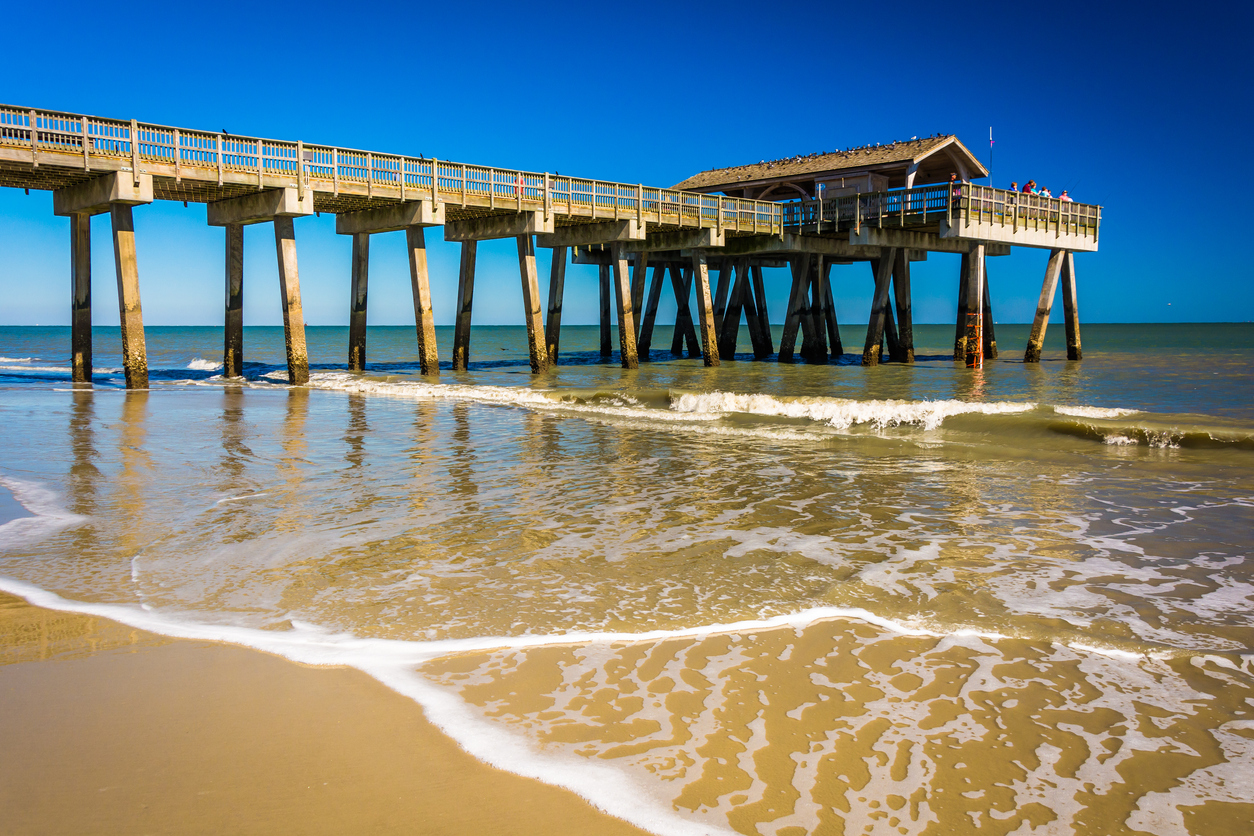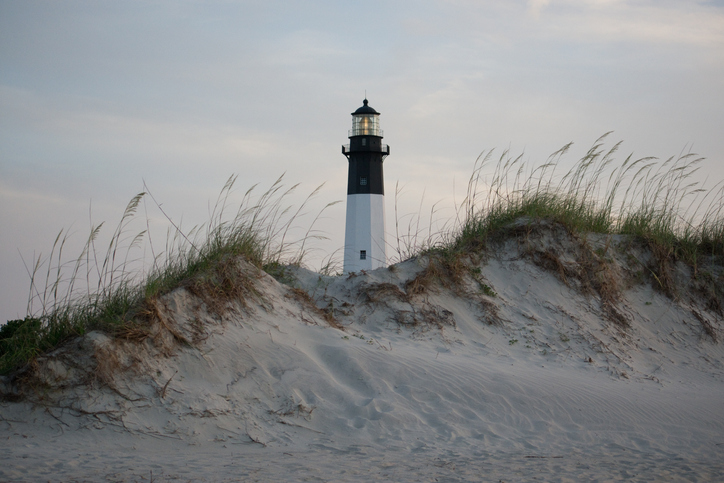

Located just a few miles from the bustling city of Savannah, Tybee Island is a popular destination for travelers looking to enjoy some time in the sun. Tybee Island is more than just a pretty beach town; it has a long and rich history dating back to the 18th century. Here’s a quick overview of Tybee Island’s past.
Tybee Island was first inhabited by the Yamacraw tribe, who called the island “Oglethorpe’s Banquet,” after the founder of Georgia, James Oglethorpe. In 1733, Oglethorpe arrived on the island with a group of English settlers, and they promptly began construction on a fortification called “The South Battery.” This fort was designed to protect Savannah from Spanish invaders, and it served this purpose for many years.
In 1742, another fort was built on Tybee Island, this one called “The North Battery.” Together, these two forts made Tybee Island an important strategic location for the young colony of Georgia. However, Tybee Island’s importance diminished in the years after the American Revolution when America’s southern border shifted further inland.
In the late 19th century, Tybee Island began to attract tourists from Savannah and beyond thanks to its sandy beaches and sunny weather. These days, Tybee Island is a popular destination for travelers from all over the world. Here are some things to do when you are on the island
The Monument is a Civil War-era fort located on Tybee Island, Georgia. The fort was built by the Confederate Army in 1861 to protect the city of Savannah from Union naval attacks.
However, the fort fell to Union forces in 1862 after just 30 hours of bombardment by new rifled cannon, which proved to be much more effective than the smoothbore cannon used by the Confederates. Today, the fort is open to the public for tours and is a popular spot for fishing, picnicking, and birdwatching.
Construction of Fort Pulaski began in April 1861 and was completed that December. The fort was built using brick and stone from local sources, and it was designed to be resistant to attack from both land and sea. The walls of the fort are 11 feet thick at the base and taper to just 3 feet at the top.
In April 1862, Union forces began bombarding Fort Pulaski with rifled cannons from a distance of over 2 miles away. Confederate forces inside the fort attempted to return fire with their own smoothbore cannon, but they were no match for the Union’s new weapons. After just 30 hours of bombardment, the Union breached the walls of Fort Pulaski and forced its surrender.
Today, Fort Pulaski is open to the public for tours year-round. Visitors can explore the rooms where Confederate soldiers lived and worked, see examples of the rifled cannon that changed warfare forever, and fish or picnic in the nearby park.
The light station is the oldest and tallest working lighthouse in the state of Georgia.
It is also one of only seven remaining colonial-era light stations in the country. The light station was built in 1736 and has been in continuous operation since that time. The museum is located in the keeper’s quarters of the light station and contains a variety of exhibits on the history of the site as well as the role of lighthouses in maritime history.
The original purpose of the light station was to warn ships of the sandbars that surround Tybee Island. These sandbars were a major hazard to shipping traffic and were responsible for numerous shipwrecks. In 1742, a hurricane destroyed the original wooden tower and it was replaced with a brick tower. This brick tower is the structure that stands today.
The Tybee Island Light Station played an important role in the American Revolution as it was used as a lookout point by American forces during the Siege of Savannah. After the war, the light station fell into disrepair and it was not until 1864 that it was repaired and relit. During this time, Tybee Island was occupied by Union forces during the American Civil War.
In 1867, a new first-order Fresnel lens was installed in the light station. This lens is still in use today and is one of only a handful of such lenses still in operation in North America. In 1933, the light station was automated and has been operated remotely ever since. In 1989, the Tybee Island Light Station was added to the National Register of Historic Places and designated as a National Historic Landmark.
The museum is located in the keeper’s quarters of the light station and contains a variety of exhibits on the history of both Tybee Island and lighthouses in general.
This hands-on museum is dedicated to educating visitors about the local marine ecosystem and what they can do to protect it. With interactive exhibits, a touch tank, and even a turtle rescue and rehabilitation program, there’s something for everyone at the Tybee Island Marine Science Center. Here’s a look at what you can expect to see and do during a visit.
The Tybee Island Marine Science Center houses a variety of exhibits on everything from local seafood to the island’s history as a resort town. One of the highlights is the “Seafood Shakedown” exhibit, which teaches visitors about sustainable seafood practices. After learning about which fish are overfished and how to properly clean and cook them, guests can sample some of the sustainable seafood options available at the on-site restaurant.
The touch tank is one of the most popular attractions at the Tybee Island Marine Science Center. Here, visitors can get up close and personal with a variety of local sea creatures including crabs, starfish, and sea urchins. The knowledgeable staff is always on hand to answer questions and teach guests about the different animals in the tank.
In addition to its educational exhibits, the Tybee Island Marine Science Center is also home to a turtle rescue and rehabilitation program. The program works to rescue sick or injured turtles from around the island and release them back into the wild once they have recovered. Visitors can learn about the work being done to protect these endangered animals and even see some of the turtles that are currently being cared for at the center.
The pier was originally built in 1891 and served as a docking station for cargo ships. In 1909, the pier was extended to accommodate the increasing number of tourists coming to the island. In 1926, the pier was again extended and a pavilion was built at the end of the pier. The pavilion served as a dance hall and music venue for many years. Today, the pier is a popular spot for fishing, sightseeing, and photography.
The Tybee Beach Pier and Pavilion has been through a lot in its 130+ year history. It has survived hurricanes, storms, and even fires. In 1956, Hurricane Gracie caused extensive damage to the pier and pavilion. The pier was repaired and reopened in 1957. In 2004, Hurricane Ivan caused significant damage to the pier once again. The pavilion was destroyed by fire in 2008. The pier was repaired and reopened in 2009.
Today, the Tybee Beach Pier and Pavilion is a popular spot for locals and tourists alike. Visitors can enjoy stunning views of the Atlantic Ocean from the pier or take a leisurely stroll down memory lane. The pavilion has been rebuilt and now houses several shops and restaurants. There is also an outdoor deck where visitors can relax and enjoy the view.
For those who enjoy spending time outdoors, there are plenty of opportunities to fish on Tybee. Here are some of the best spots to cast your line.
The North Beach Pier and Pavilion are located at the end of Tybrisa Street. This spot is perfect for fishing, as there is both a pier and a beach area to choose from. There is also a bait shop located nearby, in case you need to restock supplies.
South Beach is located at the southern tip of Tybee Island. It offers stunning views of the Atlantic Ocean and is a great place to relax and enjoy the ocean breeze. South Beach is also a prime spot for fishing, as there are often schools of fish close to shore. Just be sure to bring your sunscreen, as there is no shade available!
For those who want to venture away from the beach, Tybee Creek is a great option. This creek runs parallel to Highway 80 and offers good fishing all year round. Be sure to bring bug spray, as there can be mosquitos in this area during certain times of the year.
For those who want to venture out onto the open water, there are several charter companies that offer half-day and full-day trips. You can fish for species like red snapper, grouper, king mackerel, and cobia. All you need is your fishing gear and a little bit of patience—the charter company will take care of the rest.
With miles of coastline and plenty of places to fish from land or sea, you’re sure to have a good time—and maybe even catch your dinner!
There’s no shortage of things to do on Tybee Island! Whether you’re interested in history, nature, or just relaxing on the beach, you’ll find plenty to keep you busy during your visit.
So what are you waiting for? Grab your rod and reel and head on down to Tybee!
Sources: